Atlanta. Known for its rap artists, warm weather, and lackluster football team, has one other defining feature many of its inhabitants are all too familiar with: traffic.
Although a great city in many other ways, the seemingly endless congestion of cars among pothole-ridden roads prevent it from being equal to some of the other great cities of the U.S. The cause of this problem? Other than the geographic qualities of Atlanta’s expansion through suburbs, many put blame on one of the city’s most notable developments: the MARTA (Metropolitan Atlanta Rapid Transit Authority). Characterized by its frequent shut-downs, late train arrivals, and dirty atmosphere, the train system is greatly under-utilized as many cannot rely on it to get them places safely and on time.
As a result of Atlanta’s poorly developed public transit system, many individuals opt to drive and use their car. This great number of cars at all hours of the day has lead to more pollution and an overall worse environment for those living there.
This theme of pollution and griminess of the city was one that concerned modernists to a great degree. Artists such as Claude Monet emphasized this idea in his series of paintings The Houses of Parliament, depicting the Palace of Westminster and the River Thames over the course of several years.

In this painting, created in 1904, Monet emphasizes the degree of smog cast over the city of London. The sun seems to only partially break through the dense layer of polluted air, and the palace itself appears blurred by it. The sky is an unpleasant brown color, and the water does not look particularly clean either. Utilizing Impressionist techniques, Monet vividly depicted the sense of light within the painting and focused more on the general sense and feeling of the scene.
Atlanta (although not to as great of a degree as early 20th century London), like all cities, has generally worse air quality and environmental issues than other more rural areas simply due to the great concentration of people, especially those frequently operating motor vehicles. Renovating Atlanta’s major public transit system could help to solve this problem. With fewer cars on the road as more people use the MARTA to get around, the overall environment and air quality are bound to improve substantially. Additionally, less traffic would help the city flow better, and those that need to drive around would find themselves wasting less fuel waiting behind other cars.
I wanted to show the potential benefits of a more eco-friendly mode of transport in our current world of rising global temperatures, sea-levels, and CO2 indexes symbolically through a photograph of nature. I chose to use one I captured while in the mountains of North Carolina, the photo showing an expansive landscape of blooming wildflowers and thousands of trees, free of smog and any other environmental detriments.

To me, plants signify environmental capability and proficiency, of which an updated transit system could help Atlanta approach. I often think of the movie WALL-E, set on an earth with one singular surviving plant. That one plant allowed for the development of all other forms of life, which is what a cleaner environment allows for in general.
As I discussed earlier how Atlanta’s poorly developed public transit system leads to a worsening environment as more cars are on the road than necessary, another complication of this is the lack of personal interaction this environment produces. Cities are known for concentrating large groups of people together that will never end up forming relationships, which is something that concerned modernists greatly. The drastic shift from tight-knit communities to sprawling cities resulted in individuals being constantly surrounded by others with likely a great number of similarities and interests, but never actually getting a chance to get to know them. This led to a sense of isolation and alienation, as individuals feel even more alienated from the world because of how in a literal sense, they are among people, although for all intents and purposes they are alone.
This theme of isolation and alienation within cities is one that greatly concerned modernists. Artist Tom Hopper explored this theme in many of his paintings, and in Room In Brooklyn we can see this in great detail.
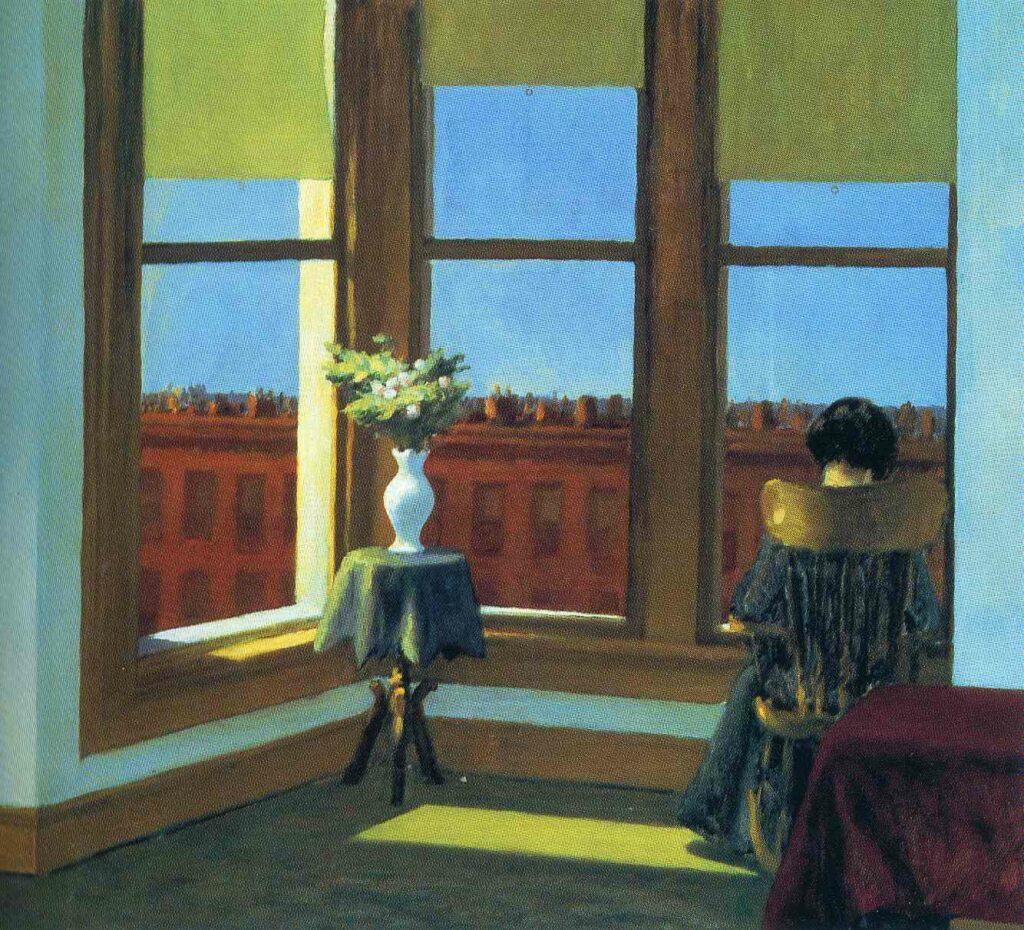
A woman is seated alone in her chair, staring outside her window into the expansive city before her. The only living thing accompanying her is a vase of flowers, well lit by the sun setting in the West. On the horizon, we see the top of a building covered in a hyperbolic number of chimneys, perhaps indicating the great issue of environmental sustainability in cities. Regardless, the painting displays the sense of isolation many of those living in cities felt, as the woman stares out of the window overlooking the city of Brooklyn, seated melancholically in a rocking chair.
One modern way the city of Atlanta could work to combat this plight of the modernist city is to, believe it or not, develop a better public transit system. An improved MARTA system that many individuals would use could be beneficial not only for the environment but for human interaction among residents of Atlanta as a whole. New York’s subway is known for being a hubbub of activity, with artists doing performative dances and music on the train. This is not seen to as great of a degree in Atlanta, simply because of the fact that MARTA is underdeveloped and fewer people utilize it for transportation. A better public transit system would quite literally force more human interaction among city-dwellers, as they would be in close proximity with oftentimes the same individuals on a frequent basis.
I decided to further this theme in the painting I created showing the value of human interaction. I elected to use one of the Modernist styles popularized by the one and only Pablo Picasso, Cubism, and illustrate individuals sitting around a table and simply interacting.
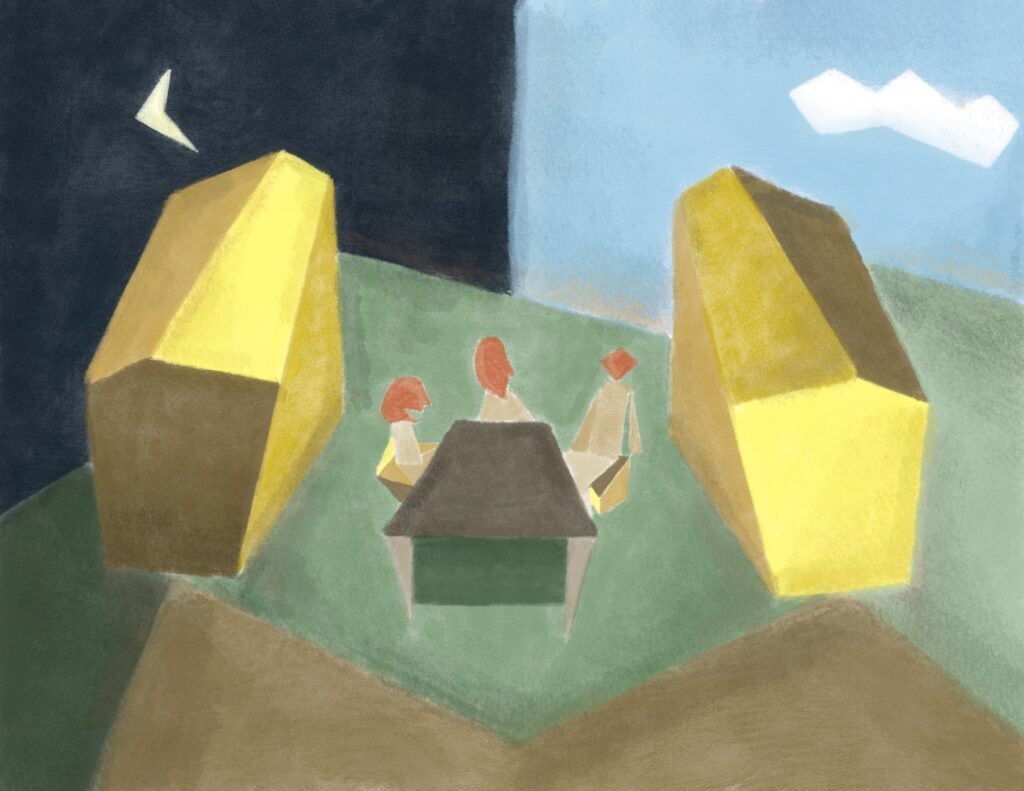
In the painting, the figures are set between two houses, indicating a more tight-knit and enclosed area of interaction and conversation. The character on the left is speaking, with the character in the middle looking towards the character on the right. In the background, the contrast between night and day is apparent, as I wanted to illustrate how conversation and discourse are essential to a day, occurring perpetually among living things across time. Ideally, improving the MARTA transit system would result in the majority of individuals utilizing its services to get around the city, leading to more conversation and friendships as individuals are enclosed in a tiny train car without much to do.
One of the other common conceptions modernists had of the city was its breathtaking size and ability to make individuals feel so small. With buildings of great heights and cities themselves being epicenters of commerce and entertainment, cities were thought to be exhilarating and shocking in comparison to the traditional towns and cities of before. Many cities were also associated with futuristic qualities as well, being the technological capitals of their relative geographic area. This more positive view modernists held of the city can be seen in Fortunato Depero’s painting Grattacieli e tunnel where he displayed many of the futuristic and modern qualities of the newfound phenomenon of cities.
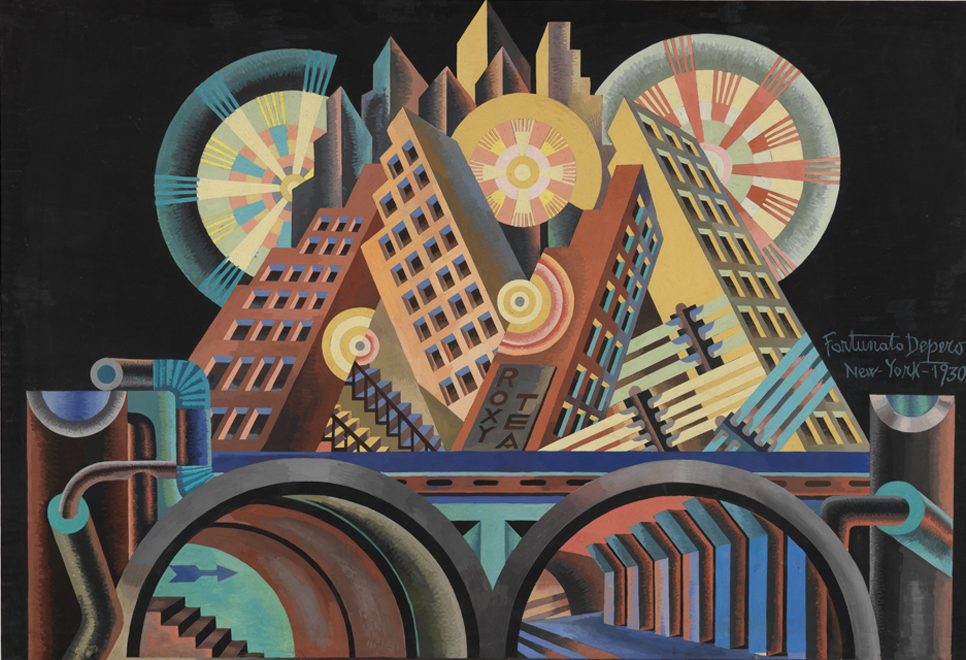
In the painting, Depero illustrates a colossal metropolis, with skyscrapers bent at unique surrounded by elevated Ferris wheels all sitting atop a network of modern and innovative tunnels. Using vibrant colors to indicate the chaotic and restless nature of the city, Depero’s employment of Futuristic techniques give the painting a more dynamic look that contributes to the rapid and mechanical atmosphere. This painting demonstrates how many Modernists viewed the development of cities in the twentieth century.
Although Atlanta does hold many of these qualities of modernity and commerce, especially the latter as many companies are headquartered in Atlanta, one aspect of Atlanta that does not follow this theme of modernity in futuristic tendencies is, believe it or not, the MARTA. Routes are inefficient, train cars frequently break down, and the stations themselves are not upkept to a satisfactory level. In one instance while riding MARTA in the morning, I actually walked by a pile of human feces on the stairwell. Not only that, but my train was delayed by 20 minutes and I arrived late to my destination. Although I have had many other fine experiences while riding MARTA, in comparison to Chicago’s “L” train or New York’s/Tokyo’s Subway system, a great disparity in the quality of public transportation among major cities becomes evident. It often feels as though Atlanta’s lack of an elite public transportation system prevents it from encroaching other cities in terms of prestige and popularity, and overall does not fit in with the futuristic tendencies modernists associate cities with.
I wanted to represent how an improved public transportation system could change Atlanta for the better, so I made a modernist image in the style of De Stijl (“the style”), a modernist art form associated with the contrasting edges and geometric shapes known for reflecting the modern urban space.
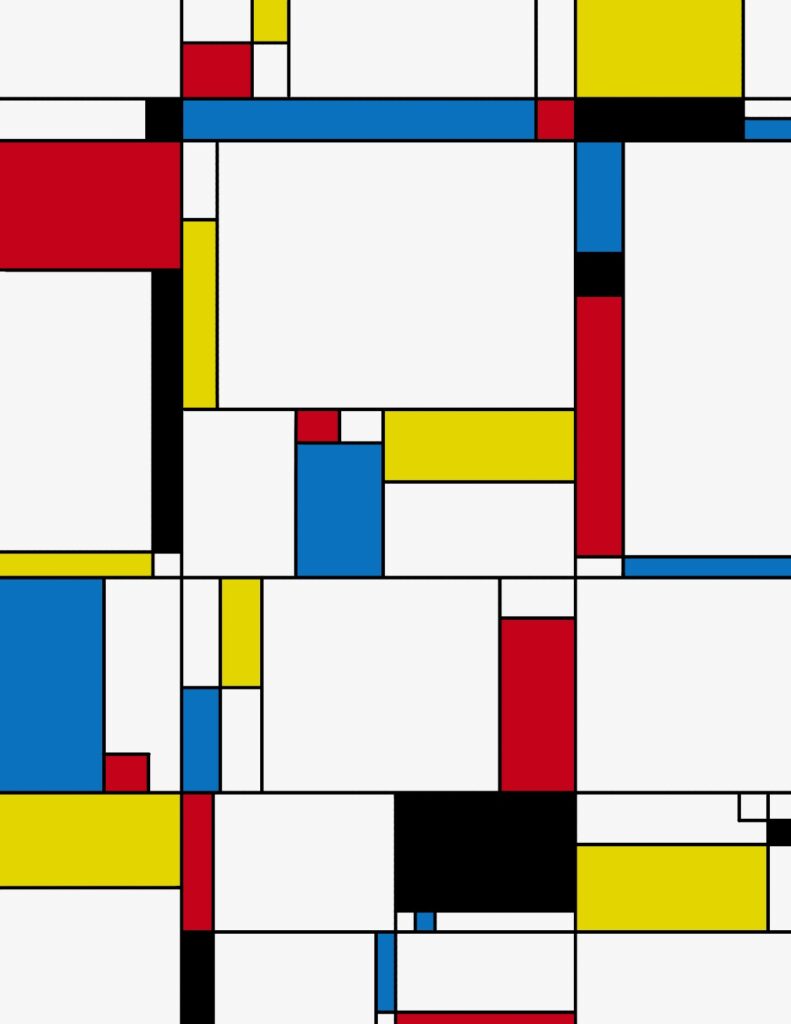
The sharp edges and unique colors indicate a more abstract modernist view, with geometric shapes and other factors utilized to promote this futuristic tone. Primary colors, along with black and white dominate the image to portray a sense of uniformity and rigidness that many associate with a modern landscape, the various rectangles working to accomplish a similar goal. This image is meant to signify the potential of Atlanta to fully encapsulate the traditional modernist view of cities being exhilarating spaces of futurism and modernity, ultimately displaying how Atlanta could appear with an improved public transportation system.
In the future, I hope that Atlanta can continue to develop the MARTA and assist it in becoming a more useful and efficient method for navigating the city. In a utopic world, Atlanta would not be notorious not for its ludicrous amounts of traffic, but known for the many other great qualities it possesses, especially its rapid and competent public transportation system.
Works Cited
Depero, Fortunato. Grattacieli e Tunnel. 1930.
Hopper, Edward. Room In Brooklyn. 1932.
Monet, Claude. The Houses of Parliament. 1904.
Tate. Modernism – Art Term. www.tate.org.uk/art/art-terms/m/modernism.
Wilsey, Matthew. “The Metropolis and Mental Life.” Modernism Lab, campuspress.yale.edu/modernismlab/the-metropolis-and-mental-life/.
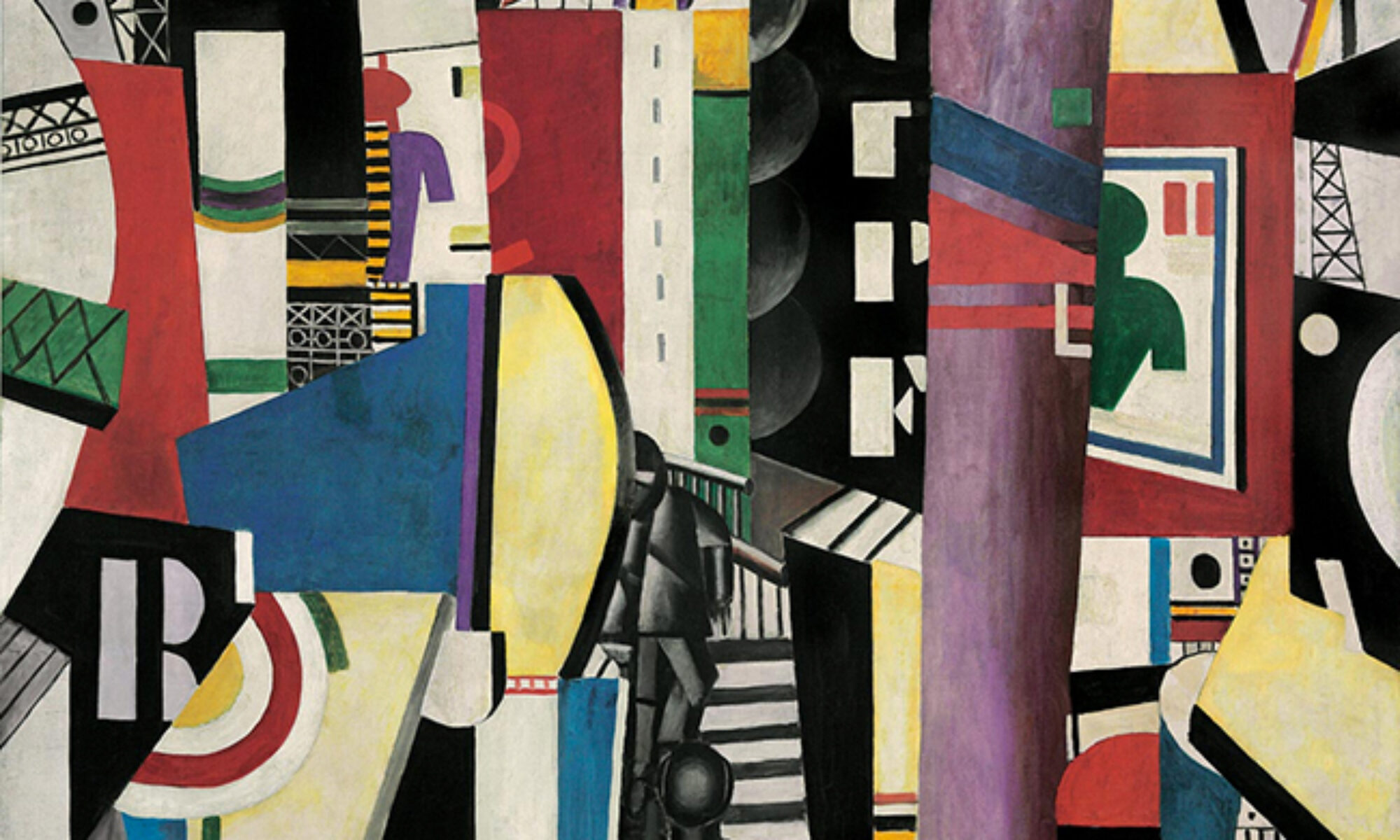
I completely agree that Atlanta has a horrendous transportation system and that this results in large amounts of traffic. Getting on I 75 right beside Tech is a nightmare. It is always filled with cars and stops consistently. There are hundreds of car on the interstate at a time, which is most definitely causing pollution. I do have one comment about this paper and it is when you talk about the transportation being underutilized. In the middle of a pandemic do you think that people are preferring to take cars or not travel at all as to not risk exposure to other and not caring about the risk of pollutions?